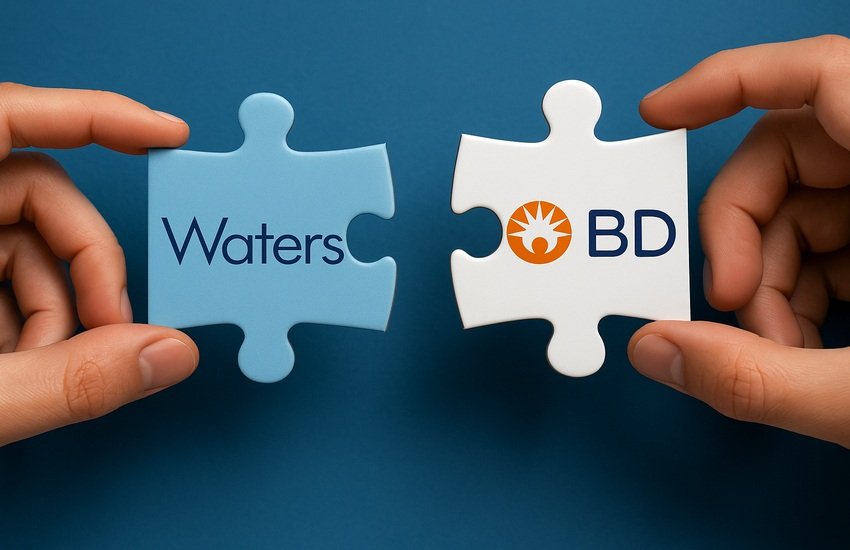Sign Up For Free To Keep Reading
Waters Corporation has officially entered a new phase of its growth journey with the $17.5 billion acquisition of Becton Dickinson’s biosciences and diagnostic-solutions business. The deal, announced in July 2025, is structured as a merger but effectively represents a strategic divestiture by Becton Dickinson, which has opted to focus more intensively on its core medtech operations. Waters, best known for its laboratory instrumentation and software, will issue 39% of its shares to BD shareholders and assume $4 billion in debt. In return, Waters will gain access to a diagnostics business that not only doubles its total addressable market to roughly $40 billion but also introduces a largely recurring revenue stream—with 70% of sales expected to be recurring annually. BD will receive a $4 billion cash distribution before the deal closes, and the combined company will be led by current Waters CEO Udit Batra. While the acquisition presents meaningful opportunities, integration complexity and investor skepticism have also come into focus.
Doubling the Total Addressable Market to $40 Billion
The most immediate and quantifiable benefit of the acquisition is the expansion of Waters Corp’s total addressable market from approximately $20 billion to $40 billion. This is driven by the inclusion of BD’s diagnostics and biosciences portfolio, which complements Waters’ existing footprint in analytical instruments and consumables. The combination positions Waters to serve a broader customer base across life sciences, pharma QA/QC, clinical diagnostics, and industrial end markets. The expanded reach is particularly relevant at a time when demand for testing solutions—from GLP-1 and PFAS to biologics and environmental safety—is rapidly accelerating. Waters already has a strong position in regulated, high-volume applications, and this acquisition enables it to enter adjacent markets that have stronger growth trajectories. For example, BD’s diagnostic platforms are more clinically integrated and cater to healthcare providers and labs—a different clientele from Waters’ primarily R&D and manufacturing customers. This presents a significant cross-selling opportunity, provided Waters can manage the complexity of selling into more regulated, hospital-centric channels. Moreover, the new entity will benefit from combined global footprints and channel synergies that could enhance distribution efficiency. The diagnostics segment also brings scale in immunology, cytometry, and molecular diagnostics—areas in which Waters has historically had a limited presence. Altogether, this market expansion provides a platform to diversify revenue, potentially buffer cyclicality in pharma CapEx, and offer a longer runway for growth if integration is well executed.
Building Revenue Stability Through Recurring Revenue Streams
One of the standout attributes of BD’s biosciences and diagnostics unit is its highly recurring revenue profile—over 70% of annual revenue is expected to be recurring. For Waters, which has traditionally been more dependent on instrumentation sales, this shifts the revenue model toward a more stable, predictable base. Recurring revenue can include consumables, diagnostic reagents, service contracts, and software subscriptions, all of which improve visibility and reduce earnings volatility. Waters’ instrument sales have historically followed CapEx cycles in pharma and industrial end markets, resulting in some lumpiness. By integrating a diagnostics business with embedded recurring revenue, Waters smooths out some of the cyclicality inherent in its model. This is particularly valuable in periods of macroeconomic uncertainty or industry-specific slowdowns, such as delays in pharma discovery or slower biotech funding. Furthermore, recurring revenues tend to have higher gross margins and better customer retention rates. Waters has already demonstrated strong performance in attachment rates for service plans, especially in downstream pharma QA/QC, and the addition of a diagnostics-focused recurring stream reinforces this trajectory. Over time, the revenue mix shift can also support valuation multiple expansion, assuming the market values the predictability and profitability of the combined business more favorably. However, recurring revenue also requires investments in infrastructure, logistics, and compliance—especially in clinical diagnostics where service levels and uptime requirements are stringent. Waters will need to scale its backend support to meet the expectations of healthcare and hospital customers, and this could weigh on margins in the short term. Still, the integration of high-quality recurring revenue is a strategic buffer that could improve financial resilience over the long term.
Synergy Potential in Innovation, Operations & Margin Expansion
Waters’ management, led by CEO Udit Batra, has identified clear paths for synergy capture from the acquisition, with targeted adjusted operating margins of around 27% initially and a goal of improving that by 500 basis points by 2030. The first area of synergy lies in product innovation. Waters has been investing heavily in new technologies such as its TQ Absolute mass spectrometer, Alliance iS HPLC systems, and Empower software platform. BD’s diagnostic platforms and biosciences research tools can potentially be integrated with Waters’ instruments and analytics, creating bundled solutions that offer differentiated performance. For instance, pairing Waters’ …
chromatography and mass spec instruments with BD’s immunology reagents could open up new use cases in biopharma QA/QC or diagnostic workflows. Second, there is operational synergy. The companies can consolidate procurement, optimize manufacturing footprints, and streamline SG&A functions. Waters has already demonstrated strong cost discipline with rapid mitigation of recent tariff impacts and a cross-functional task force approach. These capabilities could be applied to the integration of BD’s business, improving cost-to-serve metrics across the board. Finally, the margin expansion goal—500 basis points by 2030—is based on leveraging scale, improving mix through higher-margin recurring products, and eliminating overlaps. Still, such margin improvement is ambitious, and past integrations across the life sciences tools sector have often encountered cultural and logistical friction. Waters has not executed many large-scale acquisitions in recent years, so this will be a test of its integration capability at scale. Nonetheless, the roadmap for synergy capture is laid out with financial discipline and operational levers in mind.
Strategic Positioning Against Larger Competitors Like Thermo Fisher & Danaher
The acquisition of BD’s diagnostics and biosciences business enhances Waters’ scale, bringing it closer in line with industry giants like Thermo Fisher Scientific and Danaher in terms of portfolio breadth and revenue base. This has strategic importance beyond just financial metrics. In an industry where size enables deeper R&D investments, broader customer relationships, and better pricing leverage, Waters has historically been at a disadvantage compared to its larger peers. With this acquisition, Waters takes a significant step toward closing that gap. The deal introduces clinical diagnostics and cellular analysis tools that Waters previously lacked, enabling it to compete in categories where Thermo and Danaher already have a strong presence. Moreover, analysts have noted that successful life sciences platforms have often been built through bold M&A—Thermo and Danaher are case studies in this regard. For Waters, this is a deliberate pivot to becoming a more complete life sciences tools and diagnostics provider. The added scale may also improve its standing with large pharma clients who prefer fewer, more integrated suppliers. However, the comparison cuts both ways. Larger peers also have more M&A experience, deeper integration resources, and broader diversification. Waters will need to prove that it can handle a transaction of this magnitude without the missteps that have plagued other high-profile integrations in the past. Investor reaction so far has reflected this caution—Waters shares fell 14% on announcement and another 5% the next day, signaling skepticism about execution risks and synergy timelines. Despite this, if successful, the acquisition could reposition Waters from a specialized instrumentation firm to a broader platform player in life sciences and diagnostics.
Key Takeaways
Waters Corp’s $17.5 billion acquisition of Becton Dickinson’s biosciences and diagnostic-solutions business is a bold strategic move that brings significant opportunities as well as material integration challenges. The transaction substantially expands Waters’ total addressable market, strengthens its recurring revenue base, and creates a clear path toward operational synergies and broader strategic positioning. It could enable Waters to compete more effectively with larger diversified players in life sciences, while adding resiliency to its revenue model. However, the lack of historical precedent for deals of this scale at Waters, along with investor concerns around execution and margin assumptions, introduce risk factors that will need to be carefully managed. Integration success will depend on Waters’ ability to harmonize systems, align commercial efforts, and deliver on promised cost and revenue synergies without disrupting core performance. As such, while the deal has the components of a transformative transaction, it will take time, execution precision, and disciplined capital allocation to determine its ultimate impact on Waters’ trajectory.





